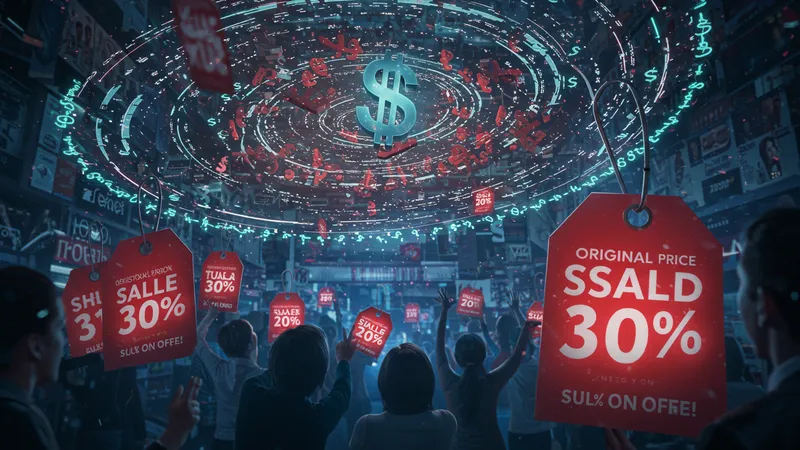Did you know that the most coveted smart watch deal might just be a glitch in the matrix? This is no ordinary shopping event, and you'd be surprised at what's fueling it.
In today's fast-paced world, staying connected isn't just a convenience—it's a necessity. With smart watches gaining incredible new features, finding the right deal is more crucial than ever.

Shockingly, insiders are revealing that some retailers are quietly slashing prices under the radar. These discounts sometimes reach up to 50%, yet aren't advertised openly—only secretive insiders know how to access them. Imagine being part of that elite group who snaps up these limited-time bargains before they're gone forever. But that’s not even the wildest part…
Perhaps even more astonishing is the rise of underground networks that predict price drops with almost eerie accuracy. These groups use advanced algorithms and big data analysis, predicting major discounts before they're advertised. Skeptical? You might be—until you see the results. What happens next shocked even the experts…
When the bells of Black Friday toll, shoppers dash from one online store to another in search of the best deals. But what many don’t realize is that behind the curtain lies a clandestine pricing war between mega-retailers. They’re continually tweaking their algorithms and strategies, aiming to outbid each other for your clicks. Yet, lurking beneath this frenzied scoreboard, lies a strategy known as price anchoring, aimed at making viewers perceive their savings as larger than they truly are.

This practice thrives during major sales when price comparison sites are overloaded. Clever marketing teams inflate an original price just days before discount season to make their offer appear more enticing. When shoppers spot the so-called discount, they think they’re saving a fortune, while in reality, the offered deal might not be as unprecedented as it seems. The real kicker is, those prices sometimes hit an even more profound low post-sale—if you know where to look.
This secret battlefield isn’t just a matter of retail warfare—it’s a high-stakes game of chess. Companies not only fight for better sales but also for customer loyalty. Implementing AI-driven market analysis, these corporations are identifying consumer buying patterns and deploying personalized offers. Who would've thought that your own browsing history would be turned against you in the hunt for a good bargain? But there’s one more twist…
What you read next might change how you see this forever. Have you ever heard of the "robo-retailers"? These are automated commerce platforms capable of purchasing high-demand products in bulk, often reducing the stock available to genuine human shoppers. They're programmed to predict and capitalize on flash discounts before they even go live. The next page reveals how these unseen competitors drastically alter the dynamics of online shopping.
The emergence of robo-retailers has changed the landscape of e-commerce beyond recognition. These automated buying entities are increasingly sophisticated, utilizing machine learning to scout for the best deals automatically, 24/7. As if an army of perfect bargain hunters, they swiftly acquire discounted goods, leaving lesser stock for human consumers. Essentially, they’re the modern-day poltergeists haunting the digital aisles.

Human shoppers find themselves in a challenging game, racing against automated bots to snag coveted deals. What stays unseen and silent is the fact that these bots are often operated by independent parties who later resell the items at a markup. This undercurrent not only inflates prices post-sale but sometimes renders the original intention of an advertised discount obsolete. It's a technological conundrum that even seasoned shoppers struggle to tackle.
This phenomenon has prompted both gurus and novice consumers alike to fight fire with fire, turning to automated deal-tracking apps designed for personal use. However, the efficacy and ethics of stacking tech against tech in this digital marketplace are up for debate. For every tool created to aid consumers, another loophole is discovered to keep them outmaneuvered.
The realization of being involuntarily thrust into this high-tech tug-of-war is disillusioning. Yet, knowledge is power, and knowing when the tide turns can lead to victory. On the upcoming page, discover innovative strategies that empower savvy consumers to reclaim their shopping advantage.
In a world where technology often feels stacked against us, resourceful consumers are flipping the script with a mix of old-school wisdom and cutting-edge tech. One under-utilized tip is shopping understudied markets—turning to less mainstream sites where the competition from bots is thinner. These sites often offer unique deals and their obscure presence means many remain untouched by automated buyers.

Further, signing up for retailer newsletters and loyalty programs can provide insider perks, giving you the head start when a sale drops before it's publicized. While it might seem tedious to sift through promotional emails, the payoff often comes in the form of exclusive offers and early access to sales.
Another secret weapon is leveraging social media. Platforms like Twitter and Facebook are gold mines for flash sales and influencer codes. By following the right groups or personalities, one can avail discounts even the shrewdest of bots might miss. It's about creating a network of information that supersedes automated algorithms.
Despite these sophisticated strategies, it’s also vital to remember the age-old advice of patience. Surprisingly, statistics show that holding off until the post-offer period can result in even better deals, as retailers reduce their inventory in bright flashes of desperation to clear stock. Just linger on a little longer for some insider insight on what to expect next as we dive deeper into timing these sales like a pro.
Timing, it turns out, is everything in the world of smart watch deals—just as in life itself. Sales events are often orchestrated meticulously, with specific products slated for release at different stages. Knowing the ebb and flow of these planning cycles can help consumers capitalize on them—much like a surfer riding the perfect wave.

Price trends show that while the early bird often gets the worm during initial sales openings, those who swoon patiently post-sales often net more significant savings. Retailers employ clearance pricing tactics that surface quietly, sometimes at odd hours where consumer engagement is presumed low. That’s when the real magic happens.
In essence, shopping becomes a game where victory doesn’t always mean the earliest access, but rather the shrewdest timing. Transforming your everyday watch shopping into an art form of patience and anticipation, brings an unexpectedly thrilling twist to what might seem a mundane task.
But how do you refine your timing to such precision? The secret lies within price prediction tools available to the public. Uncover their tactical advantages in the next section, where we’ll reveal tools designed to forecast and preserve your budget in ways you might have thought impossible.
Enter the realm of sophisticated price prediction tools—their purpose goes beyond mere alerts of price drops; they analyze market data trends to identify when the best savings occur. Seeing through the fog of marketing ploys, these tools give consumers the upper hand by predicting the best timing for purchases.

Among the ranks of these digital wizards is CamelCamelCamel, renowned for tracking price changes on Amazon, displaying the history of a product’s price, effectively showing you the true value of what you aim to buy. With such clarity, impulsive purchases become a strategy rather than a hazard.
Furthermore, Honey—an integral browser extension—scours the web for any applicable discounts or promo codes, applying the best one for maximum savings right in your cart. The savings stack without you having to do the legwork, a serene contrast to the chaos usually associated with major sales.
These tools not only aid in cutting costs but also contribute to a more mindful shopping experience. As their efficacy grows, the very necessity of staying vigilant over your purchases becomes less daunting. All is set for the savvy shopper to reign supreme—but what about the future? What lies ahead could redefine our entire shopping experience.
As fast-paced technological advancements shape our purchasing habits, the future of shopping promises not just more convenience, but possibly an experience that merges the virtual with reality seamlessly. We're on the cusp of a paradigm shift where immersive reality might blend with our commerce interactions.

Already making waves, augmented reality (AR) enables try-before-you-buy scenarios right from your living room. Imagine strapping a virtual version of the latest smart watch on your wrist before finalizing a purchase decision. This technology promises to curtail the guesswork inherent in online shopping, leading to more confident—and consequently, narrower—purchase margins.
Moreover, as AI continues to evolve, it will increasingly tailor recommendations to our individualized tastes and preferences, making impulse purchases a perfectly curated affair. The advancement of machine learning in predicting consumer desires facilitates a stronger alignment with user satisfaction, ensuring the right deal comes to the right person at just the right time.
Such innovations, while promising, bring new challenges as well—privacy concerns, data usage ethics, and an over-reliance on algorithms. However, understanding these risks could offer a clearer roadmap for technological integration. As we conclude this exploration, consider how adaptive practices and evolving tech change the way we shop. Stay tuned for a dramatic finish that illuminates the path forward in this retail revolution.
Adapting swiftly to these changes is paramount for navigating the evolving terrain of online shopping. As consumers become more technology-savvy, so must the methods that guide them. Companies are reshaping traditional strategies, opting instead for holistic approaches that focus on customer retention through digital community-building efforts.

The power of authentic reviews and influencer endorsement continues to grow. Shoppers are turning to trusted voices and verified purchasers, making collective wisdom a core component of their decision-making processes. This societal shift to communal reliance signals a rebirth of the past—it’s almost like a digital return to shopping small-town marketplaces, where word-of-mouth guided commerce.
Additionally, environmental consciousness plays an increasingly crucial role in consumer choices. Brands engaging in sustainable practices, offering transparent supply chains, and ensuring ethical sourcing are drawing in more loyalty compared to conventional titans resting on past acclaim. It's the green wave of shopping at the forefront of another revolution.
All these factors integrate to create a dynamic shopping experience that is not only tailored but also tuned to the rhythms of global conscientiousness. These elements are vital as we head toward a future coping with endless change. But the biggest question remains—how will you adapt? Equip yourself with the latest insights and discover emerging trends in the next part of our article.
Amidst soaring advancements, it’s crucial to remain wary of sophisticated marketing tactics deployed by brands aiming to sway our spending habits. These techniques are rooted deeply in behavioral psychology, ensuring that the simplest prompt can necessitate a buy. But identification is key to resistance.

Scarcity tactics are commonly employed to trigger urgencies—phrases like “limited time offer” or “only 3 left in stock” urge consumers to prioritize purchases based on fear of missing out (FOMO). Awareness allows individuals to disengage from these prompts, forcing a more rational consideration of actual needs versus forced desires.
Furthermore, bundling products, often pricing them attractively as a package, finds its roots in encouraging upsells—like the classic fast-food restaurant offering a meal instead of a standalone item. The perception of value comes into play, and traditionally, this tactic convinces consumers they’re engaging in money-saving while fulfilling wants rather than needs.
Armed with such knowledge, we can begin to see through the veils of coercive sales pushes that marketing so expertly dictates. Understanding brings the power to take control of our buying decisions, emerging victoriously from automated temptations. But there's still more to uncover—step further to unravel the final pieces of this consumer puzzle.
In the realm of digital deals and discounts, being a consumer entails much more than simply sourcing the best bargains—it demands an awareness and understanding of the predators lurking in the shadows of every magnificent sale. The term "digital predators" encompasses not just scammers, but also brands with esoteric practices.

An alert consumer, armed with research and caution, navigates this complex web by critically evaluating product information, identifying discrepancies between promises made and those delivered, and avoiding offers that seem too good to be true. Vigilance in examining seller ratings and feedback becomes second nature.
This landscape requires both intellect and intuition, as knowledge is wielded like a shield against deceitful claims and over-inflated adverts. But it’s not solely a matter of protection, it's about clever consumption—knowing when to plunge into the purchase or draw back in skepticism.
Our journey through cunning marketplace strategies uncovers depths of complex interactions between consumer and corporation. On this note, we prepare to usher in the grand finale—ponder the interconnected web of our spending habits and discover the ultimate revelation hidden within the digital commerce saga.
As we draw to a close, reflect on the transformative insights gained on this sales safari; a journey into the labyrinthine paths of smart watch retail reveals a world more calculative and strategic than face value proposes. The prowess in understanding trends, technologies, and subtleties ensures you aren’t just another number in a massive sales game.

We’ve unveiled price fluctuations, autonomous agents, bargain hunting innovations, marketing sorcery, and the art of timing—each an element crucial to harnessing the full potential of online commerce. These facets collectively illustrate the nuanced tapestry of the modern shopping experience.
Thus, do share, bookmark, or take action armed with this knowledge as our exploration into these smart shopping tactics arrives at its crescendo. What lies ahead in your purchasing expeditions will only be illuminated by continuously nurturing curiosity and refining these strategic buying practices. Observe, learn, and lead the market's pulse—one smart watch deal at a time.